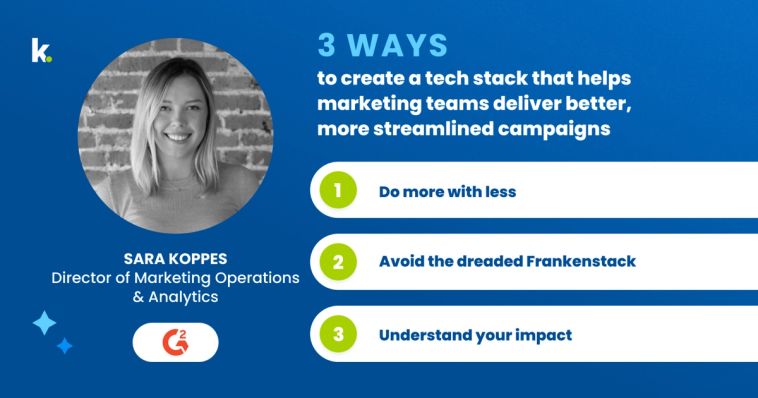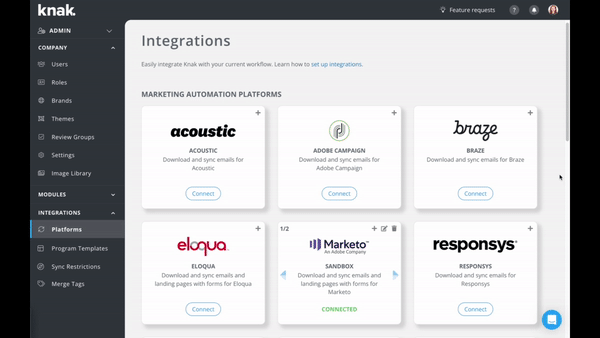The complete guide to best-in-class email and landing page creation

Summary
Explore the ultimate guide to email and landing page creation in 2024. Learn to build a robust tech stack and streamline marketing efforts.
Emails and landing pages are two of the most crucial components of any marketing campaign.
They’re used in everything from drip campaigns, webinar registrations, demand generation, content marketing, product onboarding, account-based marketing, custom pages for search engine marketing (SEM), and so much more.
In many instances, these emails and landing pages are the MVPs of your campaigns. They’re where the rubber meets the road: often, they’re the customer-facing culmination of all of your behind-the-scenes hard work. Your emails and landing pages are the direct touchpoints that help to inform, engage, and guide prospects towards a conversion, meaning they have a vital role to play in the overall success of your marketing efforts.
But for enterprise companies, it can be difficult, costly, and time-consuming to create these essential assets, particularly at the volume you really need. Whether you’re working in-house, with agencies, or some combination of both, the lead time needed to create, approve, and execute on-brand emails and landing pages can significantly hinder your campaign timelines, stifling your ability to connect with prospects and customers in relevant, timely ways.
But it doesn’t have to be like that. With the right tech stack, you can remove bottlenecks and enable the entire marketing team to self-serve the campaign assets they need, making the process of email and landing page creation accessible to all — regardless of if your team is centralized, decentralized, or using a hybrid work model. This empowers your teams to work more efficiently, productively, and autonomously, so your business can drive better results in less time.
In this post, we cover everything you need to know to create a winning email and landing page creation tech stack in 2024: the challenges and opportunities facing enterprise businesses, how to choose the right tech stack to get the biggest ROI, tips from industry experts, and our guide to the top platforms on the market for every stage of your email and landing page creation process.
The state of email and landing page creation in 2024
Today’s enterprise marketers face more challenges than ever before, such as:
Limited budgets and resources
In the aftermath of the pandemic and recent economic uncertainty, many enterprise marketing teams are under pressure to reduce costs. This means optimizing their existing resources and looking for multipurpose platforms to help their tech stack go further, as well as reducing their reliance on third-party resources like agencies.
Increased emphasis on efficiency
In addition to reducing costs, businesses want to get the most out of every dollar. To improve efficiency, enterprise marketing teams need to streamline core campaign creation processes such as email and landing page creation, even across decentralized teams. Accelerating time to market is crucial to making the most of every opportunity.
Sky-high customer expectations
Nowadays, there are a million demands for your customers’ attention. Customers have an insatiable appetite for content — and if you’re not creating it, there’s a good chance your competitors are. In order to succeed, marketers need to stand out in a more-crowded-than-ever inbox and deliver great customer experiences. Today’s marketing teams need to be able to quickly and responsively create engaging campaigns (such as targeted emails and landing pages) that meet customer expectations for personalization and capture their interest with timely, relevant messaging.
What are the benefits of an email and landing page creation tech stack?
In order to meet these challenges, enterprise marketing teams need the right tech stack to support their email and landing page creation process.
With the right platforms to support your workflow, you can turn your emails and landing pages into a competitive advantage, allowing you to:
- Work faster and reduce time to market: Replace disconnected, time-consuming creation and approval processes with effortless no-code solutions, reducing the time it takes to create emails and landing pages from days (or even weeks) to minutes
- Improve efficiency and reduce costs: Save hours on every email and landing page, protect your teams’ resources, and create a streamlined, integrated tech stack that helps your business save time and money
- Optimize resources and empower your teams: Eliminate messy back-and-forth and keep your teams focused on what they do best, while also empowering them to work autonomously and creatively
- Stay on brand and create high-quality campaign assets: Ensure every email and landing page is always on brand by setting custom pre-approved brand guidelines, removing the need for lengthy design reviews and approvals
- Improve conversion rates and drive better results: Get more emails and landing pages in market ASAP without increasing headcount or resources, so you can capitalize on every opportunity, make a real impact, and iterate on your wins

What makes a good campaign creation tech stack for emails and landing pages?
With these benefits in mind, you can start to assess the tech that’s currently at your disposal — and figure out what’s missing. But with so many tools and platforms on the market, how do you choose the right ones for your enterprise business?
Here are six questions to help you curate your perfect campaign creation tech stack for emails and landing pages.

1. What exactly does it do?
Why use multiple tools when one will do? Look for multitasking platforms that can do double (or triple) duty by facilitating several stages of the email and landing page creation process. This helps to keep your campaign creation tech stack lean, and saves money by reducing the number of single-use tools you need.
2. How easy is it to use?
Your campaign creation tech stack should improve your workflow, not be another tool for your team to wrangle. The ideal software is intuitive for your team to use and will make their jobs simpler and more efficient, without the need for heaps of training just to get started.
Look for platforms that are truly no code and offer features that make creating emails and landing pages effortless, such as drag-and-drop editors. This will empower everyone to create beautiful, on-brand campaigns, with no coding experience, developers, or agency resources necessary (until it’s time for your marketing ops team to take over).
3. Does it integrate with the other platforms you use every day?
When it comes to creating a time-saving and efficient tech stack, integrations and automations are key. Integrating the platforms you use every day, such as your project management and collaboration software, your translation tools, and your marketing automation platform, can win back hours for your teams. It also reduces the need for manual data entry (and the errors that can creep in with it).
Pro tip: Look for a campaign creation platform that’s agnostic and can work with multiple marketing automation platforms, depending on your business’s needs. This has both short-term and long-term benefits: not only does it streamline your process right here and now, but it also helps to future-proof your work in case you change marketing automation platforms down the line, so you won’t need to start from scratch and build all new templates.
4. How will it improve processes and workflows?
What are the current pain points your team faces when creating emails and landing pages? Look for platforms that can address these blockers and unlock major efficiency improvements, such as:
- Removing the need for additional resources
- Accelerating time to market
- Reducing time spent on every email and landing page (and winning back hours for your creative and technical teams)
- Helping decentralized global teams to collaborate more efficiently
- Enabling marketers to self-serve and work autonomously when creating emails and landing pages
- Empowering creativity while protecting your brand
5. Does it safeguard your brand?
Enterprise teams need to strike the right balance between creativity and brand compliance, especially for high-visibility assets like emails and landing pages. But when you have comprehensive brand guidelines, as well as multiple sub-brands and product lines with their own additional requirements, it can be challenging and time-consuming to ensure you’re getting everything right.
When building your email and landing page creation tech stack, look for platforms that offer robust brand control, such as allowing you to set up pre-approved fonts, images, colours, and more. This means your marketing teams can work within these pre-approved guidelines without hindering their creativity or slowing down their process, so they can create with confidence and get it right every time.
6. Is it made for enterprises?
There’s lots of great software out there, but some will be better suited to small and midsize businesses (SMBs) rather than enterprise marketing teams.
Enterprises have different requirements to other businesses: you’re operating on a larger scale, working across global teams, and marketing to a greater number of prospects and customers. You may also have more complex processes to navigate or more comprehensive brand guidelines to adhere to. As such, you need an email and landing page creation platform that can meet your unique challenges, including scalability, personalization, translation, and enterprise-level security standards.
Expert tips for building better campaign creation tech stacks
When it comes to building world-class tech stacks for campaign creation, what’s top of mind for marketers this year?
We spoke to industry experts and asked them one simple question: “Any tips for creating a tech stack that helps marketing teams deliver better, more streamlined campaigns?”
Here’s what they had to say…

Adobe
Nick Arehart, Product Manager, DX Marketing Operations
1. Adopt a user-centric mindset
This one is specifically for those in a position to procure or build new marketing tools for your company: adopt a user-centric mindset. I think as a marketing, marketing operations, or IT leader, one of the most effective things you can do now to improve the state of your martech stack is to spend some time with your marketing end users (that is, the actual marketers doing the work of building landing pages, sending emails, creating marketing automation campaigns, and so on) to understand their daily workflow and especially to learn what they struggle the most with day to day when using their tech tools.
That feedback from users should be the most salient information in making new roadmap or procurement decisions. Whenever you’re considering a new feature, or a new product, the decision should always come back to: how will this help our users succeed?
2. Minimize manual data entry
This one sounds simple but it’s absolutely crucial. Take the time to map out the journey a user (or team) has to go through when creating and executing a new marketing campaign. Count the number of times crucial information has to be entered by hand, or data created in one place has to be manually re-entered elsewhere.
Each manual data entry step is a failure point where users will have to slow down or stop working and may accidentally enter the wrong information — which can compound into massive data quality problems down the line. Every data entry step you can automate will pay for itself many times over in user satisfaction, campaign time-to-market, and data quality gains.
3. Take advantage of no-code solutions wherever possible
Marketing is a particularly time-sensitive endeavour, and the most successful marketing teams can put out socially-relevant marketing, informed by the events of the day, consistently and at a high level of quality. That’s very difficult to accomplish if you’re dependent on handwritten code and engineering sprint cycles for simple tasks like “create a new email template,” “import a new list of leads and contacts,” or “launch a new webpage.”
Between Adobe’s own low- and no-code product offerings and the robust and growing market of codeless and AI-driven point solutions on offer, it’s never been easier or more important to choose products that empower your marketers to work autonomously and with minimal engineering dependence.

Fullstory
Sarah Sehgal, Director of Demand Generation
1. Understand your process
A good campaign creation tech stack is about ease of use, ability to collaborate quickly, and alignment with team structure and goals. That last one can be tricky and really requires the team to understand their process. Stacks can look wildly different but be equally productive depending on the teams using them.
2. Map out your campaign
As mentioned above, it’s crucial to know your process. We learned this the hard way after having multiple tools in place for over a year that were shelfware. Map out your campaign, including all parties involved from ideation to reporting results. Use a tool like Miro to visualize what you think it looks like, then get stakeholder input. Most teams will uncover nuances and likely come out of it with a different process flow than what they started with. It’s at that point that you determine where tech can help bridge gaps and drive efficiency at scale.
3. Invest in efficiency
We’re investing in ways we can improve ROI, whether that be input based (production time, process improvement, saving hours, scaling experimentation) or output (ROAS, pipeline contribution). We’re also investing more time and money into customer marketing, which I’m seeing all over social as well.

360Learning
Justin Norris, Director of Marketing Ops
1. Understand your team’s priorities
Start with a list of priorities that are important to your team. Some teams want to create entirely bespoke emails for every campaign. Others are fine with something templated. These needs will dictate your process and tech strategy.
2. Create repeatable templates and systems
Create repeatable templates and systems and enable your teams to use them. For example, if you use Marketo, you can create cloneable program templates that hugely streamline campaign production. Ensure you also provide the necessary support and training to use them well.
3. Decentralize your process — with guardrails
If you have a lot of less technical users and a high-volume of campaigns, it’s well worth investing in tech that provides a streamlined interface for those users to build and launch campaigns. This allows you to decentralize your process while leaving guardrails in place.

G2
Sara Koppes, Director of Marketing Operations & Analytics
1. Do more with less
Like many others, we’re hyper focused on the concept of “do more with less.” For us at G2, this means evaluating our tech stack to ensure it builds efficiencies within our campaigns, but doesn’t require significant overhead maintenance.
2. Avoid the dreaded Frankenstack
Think through your investments. While it’s easy to be distracted by “shiny object syndrome” when it comes to all the new tech offerings available, it’s important to have tough conversations around impact and resources. This prevents the dreaded “Frankenstack” — a monster created from an over-bloated tech stack. The goal is to streamline and optimize, not overcomplicate. If you’re not seeing how a system will provide ROI for your business, and instead will increase confusion and complexity in your campaigns, drop it.
3. Understand your impact
A good campaign creation tech stack is one that allows you to hit your target market in a streamlined, organized way with custom messaging while maintaining your brand throughout. A great campaign creation stack also includes the ability to track your performance across each channel you’re using.
The anatomy of an email and landing page creation tech stack
We believe that behind every great email and landing page, there are five key stages: request, create, test, collaborate, and execute. Here’s what each stage looks like, as well as the types of tech to consider at each one.

1. Request
Before you get started, you need a plan. This stage involves defining your campaign objectives and identifying your target audience. You’ll also need to develop a campaign strategy and set a budget. Then, once you have all these details, you can kick off your email and landing page creation with an official request.
Pro tip: Project management platforms are great here. While they’re not “campaign creation platforms” per se, they have a critical role to play in helping you to set up, organize, and run your campaign. Using a project management platform is a great way to manage requests for new campaigns (i.e. set up an intake form), foster team-wide alignment and visibility, collaborate on tasks, and map out the logistics of your campaign to ensure you hit all major milestones and deadlines.
Platforms: Asana, Adobe Workfront, Wrike, Monday.com, Google Docs, Trello
2. Create
This stage is where the magic happens. Enable anyone on your team to create high-quality, on-brand emails and landing pages using images, text, dynamic content, and more. Gather inspiration from other businesses like yours or create your own templates that you can use again and again.
Platforms: Knak, Marketo, Stripo, Stensul, HubSpot, Braze, Constant Contact, Unbounce, GetResponse, Active Campaign, Leadpages
3. Test
The testing stage allows you to see exactly how your campaigns are experienced by all of your subscribers. It mitigates the risk that your design may look unexpectedly different on other operating systems, in a specific email client, or when viewed at different device sizes, so you can be confident that your emails and landing pages will be exactly as expected.
Platforms: Knak, Litmus, Email on Acid
4. Collaborate
This is where you bring together the expertise and perspectives of different team members and departments so you can get feedback from stakeholders and iterate on your work so far.
Pro tip: This stage can happen in project management software (like the platform you used in stage one), but finding ways to collaborate directly in your email and landing page creation platform will help you to improve efficiency even further.
Platforms: Knak, Slack, Microsoft Teams, Trello, Microsoft Outlook, Asana, Monday.com, Basecamp, Google Docs, Google Sheets
5. Execute
The execution stage involves launching the campaign using your chosen marketing automation platform (MAP), setting up tracking and analytics, and monitoring campaign performance.
Platforms: Marketo, Salesforce Marketing Cloud, Eloqua, Active Campaign, Braze, Campaign Monitor, Salesforce Pardot
13 tools and platforms to help you create better emails and landing pages
Ready to start building your email and landing page creation tech stack? Here are 13 tools and platforms you should know about.

REQUEST
What it is: Asana is a work management platform that enables teams to collaborate on projects and tasks.
Key features: Project management, workload and resource management, Gantt charts, Kanban boards, forms, reporting, automations, integrations
How it helps: Use Asana to manage the request process for new emails and landing pages. Create and manage intake forms that capture all the details you need before getting started. Map out a project timeline, assign tasks, and communicate in context to ensure your campaign planning gets off to the right start.
Alternatives: Monday.com, Adobe Workfront, Wrike, Trello
Integrates with Knak: ✔️
What it is: Monday.com is a work operating system that allows teams to manage projects, tasks, and workflows.
Key features: Dashboard, integrations, automations, Gantt charts, Kanban boards, docs, files, forms
How it helps: Monday.com is another platform that can be used to manage requests. Use its no-code form builder to create customized intake forms, then turn those requests into automated workflows to quickly notify the right people and get work underway.
Alternatives: Asana, Adobe Workfront, Wrike, Trello
Integrates with Knak: ✔️
What it is: Adobe Workfront is a project management, collaboration, and resource management platform.
Key features: Project and task management, resource management, reporting and analytics, integrations, digital asset management, review and approval process, automations
How it helps: Adobe Workfront helps marketers to manage projects, collaborate, and simplify workflows. As part of the Adobe family, it integrates seamlessly with other Adobe applications, making it easier for all kinds of marketers, from campaign managers to designers to marketing ops specialists, to work together more efficiently.
Alternatives: Asana, Monday.com, Wrike, Trello
Integrates with Knak: ✔️
CREATE
What it is: Knak is the first no-code campaign creation platform built for enterprise marketing teams that speeds time-to-market while empowering marketers to be creative.
Key features: Codeless email and landing page creation, best-in-class visual editing, dynamic content, integrations and open API, Inspiration Centre, email testing, translations, brand control, approvals, collaboration
How it helps: Knak simplifies the entire process of creating on-brand, responsive, personalized emails and landing pages. It empowers enterprise marketers to self-serve and quickly create emails and landing pages within predefined brand guardrails, using a drag-and-drop editor that removes the need for coding skills or technical resources.
By massively reducing turnaround times for email and landing page creation, marketers can react quickly to industry trends and accelerate time to market. This means your business can launch more effective and compelling campaigns without needing to add additional headcount or resources.
In addition to helping marketers create beautiful emails and landing pages faster and more efficiently, Knak works at several other key stages of the process to streamline and enhance your workflow:
Test: Use Knak to test your emails across all operating systems, email clients, and device sizes to see exactly what your audience will see (even in dark mode).
Collaborate: Easily review work and communicate in context to get actionable feedback from key stakeholders right within the Knak platform. Add unlimited collaborators, annotate your assets, and get notified when you’re tagged in comments, so you can keep work moving without needing to switch between multiple tools.
Execute: Easily sync to your marketing automation instances and sending platforms. Knak integrates with top marketing automation platforms such as Marketo, Eloqua, Salesforce, and more, meaning you only need to create the asset once and can sync it to any platform.

Alternatives: None 😉
What it is: HubSpot is an inbound marketing and sales platform that helps businesses to attract, engage, and nurture customers.
Key features: Email marketing, landing page creation, CRM, CMS, marketing automation, A/B testing, reporting
How it helps: HubSpot offers landing page and email marketing functionalities as part of its Marketing Hub product, using data from your HubSpot CRM database to drive personalization and segmentation.
Alternatives: Knak, Braze
Integrates with Knak: ✔️
What it is: Braze is a customer engagement platform that enables businesses to create and orchestrate multi-channel messaging campaigns.
Key features: Cross-channel messaging, in-app messages, email marketing, automation, A/B testing, reporting, data and analytics
How it helps: Braze empowers teams to create cross-channel campaigns that reach and engage prospects and customers at the right time. By creating a unified, personalized customer experience across multiple devices and channels (including email), businesses can design cohesive customer flows that help at various stages of the customer journey, such as acquisition, onboarding, and ongoing engagement.
Alternatives: Knak, HubSpot
Integrates with Knak: ✔️
TEST
What it is: Litmus is an email marketing platform that helps marketers test and analyze their emails.
Key features: Email builder, HTML email templates, personalization, testing, analytics
How it helps: Litmus offers a number of tests to reveal email rendering and email deliverability issues before you click send. It provides an automated QA test that checks the functionality of elements like links, images, and tracking, as well as overall accessibility.
Alternatives: Knak, Email on Acid
What it is: Email on Acid is an email testing platform that helps marketers test, analyze, and optimize their emails.
Key features: Campaign Precheck, Inbox Display, email accessibility, email analytics, email testing, image validation
How it helps: Email on Acid helps marketers to visualize how their emails will render across different email clients, devices, and browsers, including how it will look while sitting in an inbox. It also offers a Campaign Precheck, a QA checklist that tests your email’s links, images, spelling, and overall accessibility, as well as blocklist testing and spam testing.
Alternatives: Knak, Litmus
COLLABORATE
What it is: Slack is a business messaging app that allows teams to communicate and collaborate in real time.
Key features: Channels, messaging, huddles, integrations, workflows, automations
How it helps: Discuss your project, keep work moving, and increase visibility using Slack. Keep campaign-related discussions in dedicated channels where all stakeholders can see them, tag specific people to get (and give) status updates, and reach alignment using emoji reactions to quickly make decisions.
Alternatives: Knak, Asana, Monday.com, Adobe Workfront, Google Docs
Integrates with Knak: ✔️
EXECUTE
What it is: Adobe Marketo Engage (or just Marketo to its friends) is the world’s largest marketing automation platform.
Key features: Marketing automation, account-based marketing, marketing analytics, lead management, cross-channel marketing, content personalization, integrations
How it helps: Marketo is one of the most powerful marketing automation platforms out there. It enables businesses to create and send personalized, segmented email marketing campaigns, create landing pages, and analyze the performance of their campaigns.
Alternatives: Salesforce Marketing Cloud, Salesforce Pardot, Eloqua, Active Campaign, Mailchimp, Campaign Monitor
Integrates with Knak: ✔️ Learn more about the Knak + Adobe Marketo Engage integration.
Salesforce Marketing Cloud and Pardot
What it is: Salesforce Marketing Cloud and Pardot are both marketing automation products in the Salesforce suite. Marketing Cloud focuses on full-scale marketing automation and customer engagement, while Pardot is mainly (but not exclusively) used for B2B email marketing.
Key features: Marketing automation, email marketing, landing pages, data management, personalization
How it helps: Both Marketing Cloud and Pardot can be used to create email marketing and landing pages for your campaigns. Both platforms integrate seamlessly with Salesforce, meaning you can leverage rich data from your Salesforce CRM to orchestrate more targeted, personalized campaigns.
Alternatives: Marketo, Eloqua, Active Campaign, Mailchimp, Campaign Monitor
Integrates with Knak: ✔️ Learn more about the Knak + Salesforce Marketing Cloud integration here and the Knak + Pardot integration here.
What it is: Eloqua is a B2B marketing automation platform used to execute marketing campaigns.
Key features: Campaign orchestration, segmentation and targeting, lead management, asset management, reporting and analytics
How it helps: Eloqua is another platform that provides marketing automation and lead management. It’s used for campaign management, email marketing, landing pages, and more, allowing marketing teams to generate leads and drive business growth.
Alternatives: Marketo, Salesforce Marketing Cloud, Salesforce Pardot, Active Campaign, Mailchimp, Campaign Monitor
Integrates with Knak: ✔️ Learn more about the Knak + Eloqua integration here.
BONUS: What a campaign creation tech stack looks like in action
Remember: you don’t need all of these platforms, you just need the right ones. In fact, the goal is to pick the smallest number of platforms that work for you.
Here’s how we do things at Knak, using only three multipurpose platforms:

Make email and landing page creation effortless with the right tech stack
By using the right platforms for your email and landing page creation, you can help your team to work faster, more efficiently, more autonomously, and more impactfully, all while unlocking their creativity.
Ready to take your email and landing page creation to the next level? Knak has helped tens of thousands of enterprise marketers at world-class companies to do just that. Request a demo and discover how Knak can help you to improve processes and empower your teams.
FAQs about tech stacks for email and landing page creation
1. What is an email and landing page creation tech stack?
An email and landing page creation tech stack is the combination of platforms you use to plan, create, and execute emails and landing pages. These platforms can include project management software, campaign creation platforms, marketing automation platforms, and testing and QA tools.
2. What are the best platforms for email and landing page creation?
The best platforms for email and landing page creation are those that make it easy for your marketing teams to be creative, but also ensure that they’re staying within brand guidelines. For example, no-code platforms like Knak provide a user-friendly drag-and-drop interface that empowers anyone on your team to create beautiful, on-brand emails and landing pages. Look for a platform that allows you to streamline and improve your email and landing page creation process, so you can improve efficiency, optimize workflows, and scale your productivity.
3. How do you build a tech stack for email and landing page creation?
Building a great tech stack for email and landing page creation is about quality, not quantity. Look for platforms that you can use across multiple stages of your email and landing page creation process to get an even greater ROI. It’s also important to find software that integrates and works together, so you can create more efficient and secure workflows. Finally, consider how future-proof and scalable your tech stack is: is all of your work tied to one marketing automation platform, or can it integrate with multiple platforms if you decide to switch in the future?












